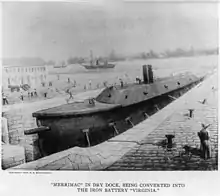Mary Louvestre
Mary Louvestre (or Touvestre) was a seamstress and Union spy in Norfolk, Virginia during the US Civil War. Mary delivered details of plans for the conversion of the wrecked USS Merrimack to an ironclad that would be named the CSS Virginia and which represented a great advance in Confederate naval capabilities.[1]
History

There are multiple accounts about her story. One account stems in part from documentation by then Secretary of the Navy, Gideon Welles. This account states that Louvestre worked with another Union Spy, William H. Lyons, who was one of the few workers at Norfolk's Gosport Navy Yard who did not flee when Norfolk was captured by the Confederate Army early in the war, but who was still providing information about the Confederacy through contacts at Fort Monroe. Welles states that Louvestre came to him in great secrecy in February 1862 with documents about the CSS Virginia from Lyons.[2][3]
Another account exists based on the work by novelist G. Allen Foster published in Ebony magazine in 1964[4] and on a history by Benjamin Quarles written in 1953[5] and which has been repeated in many other sources, including publications by the Central Intelligence Agency[6] and the US Army Corps of Engineers.[7] This account contains much more detail about Louvestre. In this account, Mary Louvestre was born in the Shenandoah Valley and was bought in her early teens by a small farmer. At the time of the civil war she may have been between 55 and 70 years old. She had a talent for drafting, and to capitalize on her skills was taught to sew and trained as a seamstress. When the farm faced two tough years in a row, they were forced to sell Mary, who was bought by his owner's cousin, Simeon[4] or John[7] Louvestre, in Norfolk.
In July 1861, she overheard her employer (she bought her freedom with her money from seamstress skills), who worked as engineer[7] or ship-chandler in Norfolk's Gosport Navy Yard bragging about the ironclad Merrimack (later renamed the CSS Virginia) they were building which would dominate the Union Navy. Early in the mornings for the next week, Mary snuck in to the engineers’ office and used her seamstress skills to trace the drawings of the ironclad.[4]
In order to get her information to Union leaders, she obtained permission to visit her previous owners in the valley. Pass in hand, she headed for Union lines near Fredericksburg[4] and with the assistance of the underground railroad, reached her destination. She was then escorted to Washington, D.C. under military guard,[7] where she met with Secretary of the Navy Gideon Welles. Welles offered Mary freedom and employment, but Mary preferred to return and await freedom in Norfolk. The Union used the information to hasten the completion of the ironclad USS Monitor, which would later battle the Merrimac and protect Union blockaders from the Merrimac's offensive power.[7]
Another contemporary account of her story, The Treason of Mary Louvestre by My Haley, was published in 2013 and is closer to the Foster version of the story.[8][9]
References
- "A true Civil War spy story: "The Treason of Mary Louvestre"". WNN. Retrieved 29 April 2016.
- McClure, Alexander K. The Annals of the war written by leading participants north and south. 1879, Philadelphia : The Times Publishing Co, page 20
- A letter by Welles outlining this is reproduced and discussed in Woman Slave's Deeds as Union Spy Long Overdue for Recognition. The Virginian-Pilot (Norfolk, VA) (Sun, 24 Mar 2002)
- Foster, G. Allen, Mary Louvestre helped defeat Rebels in crucial sea battle by spying on South. Ebony, July 1964
- Quarles, Benjamin. The Negro in the Civil War. Perseus Books Group, 1953 p92-93
- Allen, Thomas. Intelligence in the Civil War. CENTRAL INTELLIGENCE AGENCY WASHINGTON DC, 2007.
- Smith, Steven D., and James A. Zeidler. A Historic Context for the African American Military Experience. No. CERL-TR-CRRC-98/87. CONSTRUCTION ENGINEERING RESEARCH LAB (ARMY) CHAMPAIGN IL, 1998.
- Haley, My. The Treason of Mary Louvestre, Morgan James Publishing, 1 Feb 2013
- McEwen, Lauren. "My Haley, wife of Alex Haley, releases her first novel". Washington Post. Retrieved 29 April 2016.